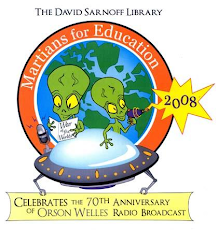David Sarnoff Library Open House
When: Saturday, July 16, 2005, 10 a.m. - 4 p.m.
Where: Sarnoff Corporation Lounge and Auditorium and the David Sarnoff Library
What: Radio repair clinic, lectures, old-time radio for children, exhibits on innovations that changed the world
Why: To promote and appreciate the innovative spirit
Cost: Free (not including parts), contributions welcome
Once again the David Sarnoff Library opens its doors and offers a variety of experiences that refire the innovative spirit in visitors. "Almost 100 years ago, David Sarnoff saw the future in electronic communications," says Executive Director Dr. Alex Magoun. "He and countless engineers, scientists, and staff at RCA and related companies have worked since then to make that future happen. We're pleased to show off some of their accomplishments and have visitors experience some of the cultural changes that resulted from their innovations."
Dr. Magoun will give an illustrated lecture on that theme, David Sarnoff and the Innovative Spirit, at 11 a.m. and 2 p.m. in the Auditorium. The basis for the coming redesign of the Library's exhibits, the lecture shows how Sarnoff expanded the possibilities for electronic media throughout his life and through the legacy of Princeton's David Sarnoff Research Center.
There were will be numerous other activities as well, including
1. Gary Wilson, Public Information Officer of the American Radio Relay League, will offer a display and offer visitors use of an amateur radio station. Amateur radio volunteers and their technology operate emergency communications in networks throughout the world wherever power lines have failed; they also use the technology for Morse and voice communications as a hobby that dates back to the beginning of Sarnoff's career one hundred years ago.
2. Visitors can compare radio culture for children in the 1920s and 1930s with the electronic entertainments that they enjoy today through computer games and DVDs, courtesy of Friends of the Library Jerry and Marsha Simkin. What did people listen to on the radio 50-70 years ago? Hear for yourself on a variety of working antiques...
3. Puzzling over the value, condition, or future of your old radio? The New Jersey Antique Radio Club offers a free clinic. Call (609) 734-2636 with the make and model to make an appointment on the hour for one-on-one attention. Many radios can be fixed in less than 60 minutes, and the New Jersey Antique Radio Club’s experts will do it for free! Parts are not included but are generally surprisingly inexpensive.
4. The museum will be open and include the following exhibits.
A. Sarnoff's career started with radio, which looked quite different from today's products. RCA's first radio from 1922 would have a hard time fitting on your bedside table, or in your car or pocket. The 1928 RCA-Victor home entertainment system that Sarnoff conceived of, combining record player and radio, probably wouldn't fit with the decor in your home either, and it doesn't play digital media.
B. Remember records? You can see an exhibit showing the iPod of its generation, RCA Victor's revolutionary record changer from 1949 and the seven colors that 45s first appeared in. The world’s first 45, invented in Camden, is on display while a working 45 Victrola and a Columbia cylinder Graphophone will play some of the sounds you want, when you want them.
C. Electronics became smaller with Bell Labs' invention of the transistor, and researchers in Princeton improved on it to make possible the smaller and versatile devices on which we rely today. See the world’s first transistor radio and the first solid-state video camera, designed and built at the David Sarnoff Research Center in the early 1950s. See yourself in living black and white through a 1951 TV camera on the 1948 RCA television--both built in Camden--that started America's video age.
D. RCA’s first color television, the CT100, is rarer than a Stradivarius violin but you can watch a variety of antique color videos during the day.
E. Why do televisions have to be so boxy? Former DSRC researcher George Heilmeier just won the Kyoto Prize for leading a team in the invention of the first liquid crystal displays (LCDs), based on a discovery by the DSRC's Richard Williams. The LCDs inspired researchers around the world to develop the flat panel screens we use in everything from cell phones to wall-size video. You can see the notebooks and early LCDs on display.
Call (609) 734-2636 for more information, and visit davidsarnoff.org for directions.
This event is made possible in part through a general operating support grant from the New Jersey Historical Commission, Department of State.
Friday, July 08, 2005
Subscribe to:
Comments (Atom)


